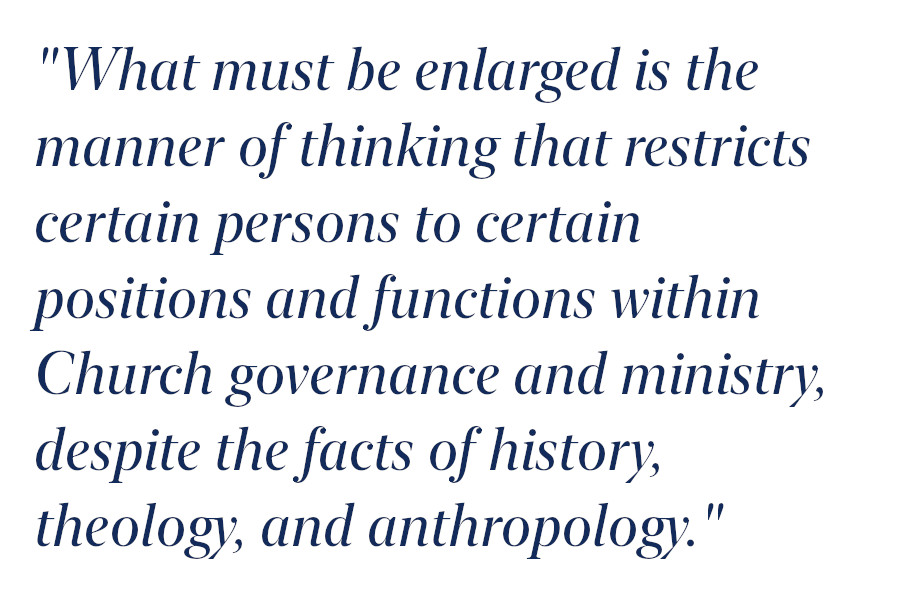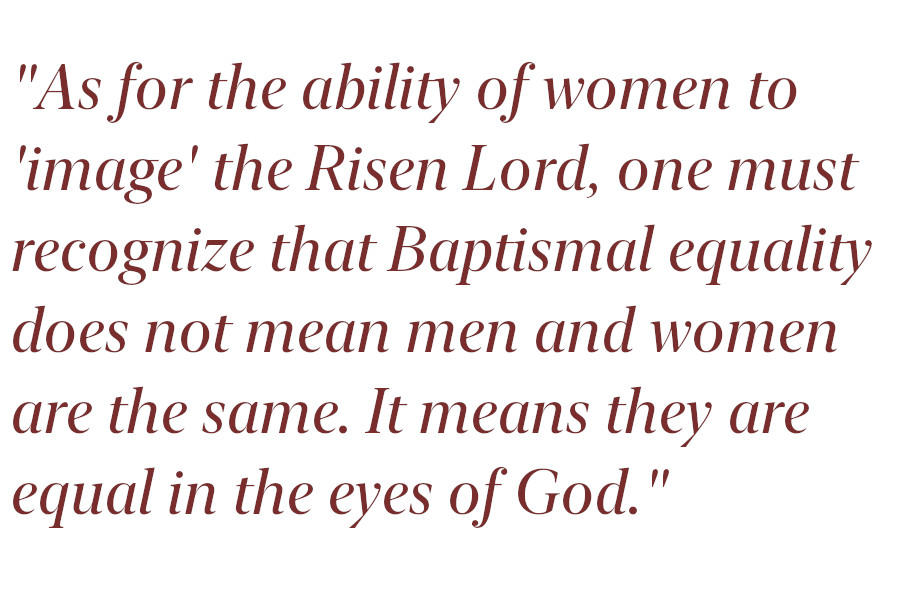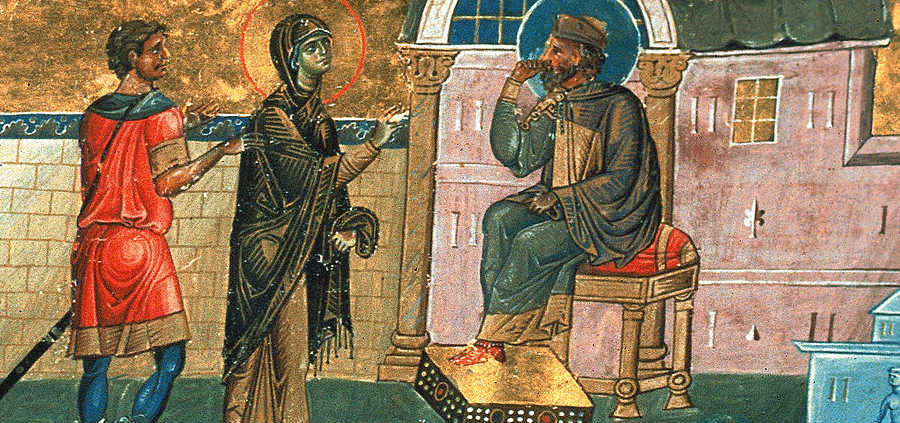“An Important Step Forward”: An Interview with Phyllis Zagano
This is an English translation of an interview with Ángel Alberto Morillo that originally appeared in the February 23, 2024, edition of Vida Nueva. We are grateful to the author for permission to reprint it in Today’s American Catholic. The original article is available here, and Phyllis Zagano’s recent piece “Synodal Discernment and Women in the Diaconate” is available here—Ed.
What do you think about the first phase of the 2021–2024 Synod, especially about the participation of women?
The first woman to have a significant position in the Curia was the Australian laywoman Rosemary Goldie (1916–2010), who was undersecretary of the then-experimental Pontifical Council for the Laity from 1967–1976. In her memoirs, Ms. Goldie wrote that this “first timid opening of the Curia to lay people, and even to women, required nothing less than an Ecumenical Council.” Despite Pope Paul VI’s apparent support of women in the Curia, when the Council became permanent a priest was named as its undersecretary. Ms. Goldie remained in Rome as a professor at the Lateran University until her retirement.
While the Second Vatican Council held its first two sessions with only male lay auditors (Goldie joined some 20 other women as an auditor for the final two sessions), today we see the Synod of Bishops transformed to a Synod of the whole Church. The fact that 54 women—both secular and religious—were among the Synod meeting’s 365 voting members demonstrates the Church’s progress in recognizing women’s abilities and importance.
From the outside looking in, the Synod meeting in Rome seemed to be a collegial gathering of like-mined individuals—men and women of various states of life—all willing to help in the building up of the Church. The participation of women in the October 4–29, 2023, Rome meeting partly represented women’s participation in earlier Synod stages, from the initial diocesan and episcopal conference meetings, through the continental stage consultations, to the process for nominating continental representatives to the Rome meeting. Episcopal conferences from the continental stage of the process were asked to name 20 possible participants, half of them women, of whom 10 were named as Synod participants.
The participation of women at the Rome Synod marked an important step forward.
The permanent diaconate of women is a “sensitive” issue for many in the Church, especially in the hierarchy. Do you think it can thrive?
The restoration of women to the ordained diaconate recognizes the past, the present, and the future. The Synod Synthesis Report, entitled “A Synodal Church in Mission,” presented the discussion about women deacons as follows:
Different positions have been expressed regarding women’s access to the diaconal ministry. For some, this step would be unacceptable because they consider it a discontinuity with Tradition. For others, however, opening access for women to the diaconate would restore the practice of the Early Church. Others still, discern it as an appropriate and necessary response to the signs of the times, faithful to the Tradition, and one that would find an echo in the hearts of many who seek new energy and vitality in the Church. Some express concern that the request speaks of a worrying anthropological confusion, which, if granted, would marry the Church to the spirit of the age. (9.j.)
The Synthesis Report demonstrates the uneven knowledge of the diaconate and of women’s participation in it. It is important to remember that not all the Synod members are theologians or historians, and not all come from cultures that respect women’s baptismal equality. To be fair, the Synthesis Report proposed that:
Theological and pastoral research on the access of women to the diaconate should be continued, benefiting from consideration of the results of the commissions specially established by the Holy Father, and from the theological, historical and exegetical research already undertaken. If possible, the results of this research should be presented to the next Session of the Assembly. (9.n.)
The most important point in the Synod proposal is the request that research “already undertaken” be included in the presentation to the October 2024 Synod meeting. The discussion will go forward. Whether it will prosper or not depends on whether the facts are available and are prayerfully considered.
In the Synthesis Report it says that during this year a commission of theologians will delve deeper into the topic of the female diaconate. What do you think about that? Will there be room in the tent?
Since the Second Vatican Council, the question of restoring women to the ordained diaconate has been studied by five different Vatican bodies: three times by sub-commissions of the International Theological Commission (1971–1973; 1992–1997; 1997-–2002) and twice by pontifical commissions (2016–2018; 2021–2022). It is entirely possible that for these studies the same topics were reviewed, and the same conclusions drawn.

A new group of theologians looking at the topic may come to it with the prejudices evidenced in the Synthesis Report. Before reviewing any materials, some believe that ordaining women as deacons restores the practice of the Church. Some believe that ordaining women as deacons is a break with Tradition. Similarly, some believe that the recognition of women’s Baptismal equality will bring new energy to the Church’s mission. Some believe that ordaining women as deacons displays, as the Synthesis Report calls it, “anthropological confusion.”
The Synod’s challenge to its participants, indeed to the entire Church, is “to enlarge the space of your tent” (Isaiah 54:2). In fact, that is the title of the Working Document for the Continental Stage: “Enlarge the space of your tent.”
Yet it is not only the “tent”—the space for people to participate—that must be enlarged. What must be enlarged is the manner of thinking that restricts certain persons to certain positions and functions within Church governance and ministry, despite the facts of history, theology, and anthropology.
Even with all the historical evidence about the female diaconate, is there resistance?
Resistance to restoring women to the ordained diaconate comes from refusal to accept the historical facts of their ministries, the sacramentality of the liturgies used to ordain women, the distinction between the diaconate and the priesthood, and the Baptismal equality of women with men.
Therefore, there are two types of objections to the historical evidence of women ordained as deacons: 1) female deacons did not perform the same tasks and duties as male deacons; 2) female deacons were only “blessed,” not ordained.
In addition, there are two types of theological/anthropological objections to women being ordained as deacons: 1) the “unicity of orders,” which argues that because women cannot be ordained as priests, neither can they be ordained as deacons; 2) the “iconic argument,” which states that women cannot image Christ.

The objections have been answered by scholars many times.
Women deacons performed the tasks and duties assigned to them by their bishops, and not every era and location had the same needs. They were ordained, often with the same liturgies used to ordain male deacons, which meet the criteria established by the Council of Trent for sacramental ordination.
The sacrament of Holy Orders is clearly defined. The diaconate is not the priesthood, and diaconal ordination does not imply eligibility for priestly ordination. As for the ability of women to “image” the Risen Lord, one must recognize that Baptismal equality does not mean men and women are the same. It means they are equal in the eyes of God.
Underlying many, and possibly all these objections are taboos inherited from the ancient world about the “uncleanness” of women. In the 5th century, Pope Gelasius I complained that women (presumably women deacons) were serving at the altar, and by the 14th century, most female altar service was only a memory. However, that memory was recalled by the monk Matthew Blastares, who attributed the ban on women at the altar to superstition about menstruation. Only gynophobia and misogyny contribute to such objections today.
What does the presence of women as formators in seminaries contribute to dismantling these prejudices?
Formation in seminaries, called for by the Council of Trent, has evolved differently in different cultures over the centuries. The unfortunate commonality of too many formation programs is a type of monastic sequestering of priest candidates combined with an early (and unofficial) clericalization. Seminarians are dressed in clerical attire long before they become clerics, and they are incorporated into an all-male society before they learn how to relate as adults to anyone outside that society. Including women as formators is a step toward normalcy, but the Church needs to recognize that young men’s brains are not fully developed until they are in their mid-twenties. Therefore, to restrict young seminarians from normal society and then ordain them before they are fully mature is a crime foisted on the entire Church.
The Synod Report proposes “that women should also be integrated into seminary teaching and training programs to foster better formation for ordained ministry.” (Report 9.p) and specifically recommends:
Formation for ordained ministers should be designed in a way that is consistent with a synodal Church in the different local contexts. Before embarking on specific paths candidates should have a significant, albeit initial, experience of life in a Christian community. Formation should not create an artificial environment separate from the ordinary life of the faithful. (14.n.)
Therefore, recognizing the facts and dangers of all-male seminary formation of immature men, the Church can and should move to reconfigure seminary formation, beginning with the inclusion of more women as faculty and spiritual directors, and especially on the panels that meet to recommend individual seminarians for installation as lector and acolyte, for ordination as deacon, and for ordination as priest. ♦
Phyllis Zagano, Ph.D. was a member of the 2016–2018 Pontifical Commission for the Study of the Diaconate of Women. She has written widely on women in the Church, and her most recent book is Just Church: Catholic Social Teaching, Synodality, and Women (Paulist Press, 2023). She holds a research appointment at Hofstra University in Hempstead, New York.




A very clear, lucid, reasonable, intelligent and logical explanation of the position of women in the diaconate and beyond. It stimulates the fundamental sense of reason and logic in human nature. It should not get lost in the shuffle of writings and opinions in the post-synodal flurry.
Great job. I would ditto everything Gene Ciarlo said. Great explanation of what was and hopefully will be.